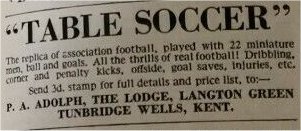
| Peter Upton's |
|
Subbuteo Tribute Website. |
|
Subbuteo Advertising. |
|
The UK Magazines that carried Subbuteo adverts. |
The Team Colours Project (Ongoing illustrated team lists).
Subbuteo Football boxed editions, Five-a-side and junior versions.
Subbuteo Catalogues: 1947-1970, 1971-1996 and misc flyers.
However fantastic a product may be, an advertising campaign is vital to bring it to the masses. From the very first, Peter Adolph used magazines and comics to promote his games and products. This was especially vital in the 1950s when the product was mail-order only, but these ads carried on into the 1990s becoming more sophisticated as time went on.
Magazines and newspapers are generally ephemeral, i.e. they are read and then discarded. Nevertheless, magazines in the second half of the twentieth century had huge distribution figures, so some issues survive. These remaining issues are often still cheap and disposable. I have noticed several ebay entrepreneurs trying to extract extra value from old football magazines by cutting them up into linked articles relating to club information or other items of interest. This includes groups of Subbuteo advertisements, and these auction lots reveal a huge and fascinating field. There is a lot to cover. I'm not sure I approve of cutting up historical publications, but as most of my magazines went into landfill years ago, I suppose I shouldn't be too critical.
However, I did not want to just copy a gallery of adverts from the internet. The trouble with these cut-out adverts is that they have no cultural reference. They have no details of publications or dates. For the would-be historian, this is rather frustrating.....
So this page takes a different route. The idea is too look at the evolution of the Subbuteo advert, alongside the history of the publications that Peter Adolph, and later Subbuteo Sports Games Limited chose to advertise their wares. I plan to show a wide range of publications from different eras, alongside the relevant Subbuteo adverts. I'll give a little history of the magazine itself, and a look at contents and other advertisers. I've also added a few pictures of rival game adverts, just for fun.
March 2022: The page launches with a few magazines that I personally own, and a couple of others whose contents have been scanned onto the internet or into books. So far, the early period is covered quite pleasingly, but I have yet to tackle much of the Waddingtons years - meaning Shoot!, Match, Roy of the Rovers and the like. If you own magazines of this vintage, and can scan in the covers and adverts, I would be grateful.
Bibliography.
Beyond the standard Subbuteo history books (which I've name checked when appropriate), the following books/sites were useful in constructing this page, and are a recommended read.
Football's Comic Book Heroes by Adam Riches with Tim Parker and Robert Frankland (2009 Mainstream Publishing). This hardback is probably the ultimate reference to the football stories within Britain's comics. Companion volume "When the Comics Went to War" (2009) by the same authors was also used for some general dating (and a Targette advert).
The Best of Charles Buchan Monthly - Edited by Simon Inglis (see below).
Studs! (2006 Ebury Press) - A small retro collection of Shoot! pictures and articles from the 1970s-80s, with a comedy angle. Many of the larger pictures focus on famous pundits and managers (from 2006) in their playing days (Martin Jol, Sam Allardyce etc). There doesn't seem to be a Subbuteo advert in the book sadly, but there is the famous Snoccer advert - a game that was a mix of Snooker and football. Okay, no Subbuteo but I'm recommending it anyway.
Rare Footy Stuff; Footballing Memorabilia & More - This has scans of old 1950s magazines like Sport and Charles Buchan's Football Monthly.
The Boy's Own Paper. (August 1946).

Okay, I don't have a cover illustration, but we need to start with the original advert posted by Peter Adolph in August 1946, essentially to test the interest for his new (and as yet un-produced) table soccer game. This is the only advert I have seen that does not use the "Subbuteo" name. At the time, Adolph was still hoping to call his game "The Hobby". Despite the advert being exceeding vague, the huge response enabled Adolph to finance the initial run of the game.
The most important thing about this advert is that is does not match to Peter Adolph's origin tale, as told to Richard Payne for Fifty Years of Flicking Football, and further detailed in Mark Adolph's biography. The story goes that Peter Adolph advertised his original game set at 7/6d (a figure he plucked out of the air), and the flood of replies with postal orders made Peter Adolph rush to produce the game. However this advert only asks for 3d for "full details and price list". As Daniel Tatarsky points out in Flick to Kick, Adolph is only offering an advertising leaflet (and the punter has to pay for it). I suppose if the £7500 figure is true, then it is even more impressive if each postal order was only 3d.... Perhaps the full figure of Adolph's tale jumps a stage to make a better story. Was this figure from was the response after the leaflets were dispatched? There is probably nobody to answer this question, and it doesn't really matter much. The key thing is that the advert was a success and with few overheads, the game became self-funding.
The Boy's Own Paper was a long running publication, which began in 1879, and ran until 1967. Appropriately, the cover story for the very first issue in 1879 was entitled "My First Football Match", although it was about public school football, and the illustration looks closer to rugby. For most of its life the paper was a monthly. This was an old style boy's magazine, where the stories were full text, and not comic strips. The contents reflected the Victorian origins, with patriotic adventure stories, as well as those set at school (usually a public school). It also featured articles on subjects deemed fit for young boys - nature studies, sports, and practical skills. Many of the famous Biggles stories were published here between 1941 and 1961.
Even in 1946, The Boy's Own Paper was a rather old fashioned publication, and not one of the best selling boy's magazines. Perhaps the advertising rates were reasonable, or maybe Peter Adolph had read the magazine as a child? Adolph's tiny advert took its place among the usual postage stamp offers, some "healthful confections" (Barley sugars and glucose tablets), and an illustrated bicycle pump.
Sport Magazine 13th March 1948 and 8th July 1949. (later Sport Weekly/Sport Express).
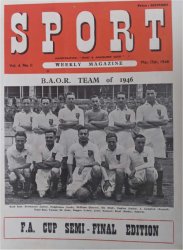
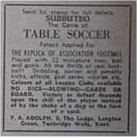
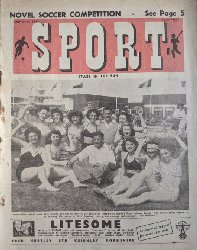
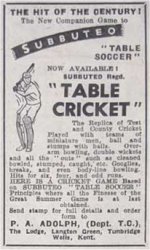
Sport magazine is another title that we know Peter Adolph used in the 1940s. Richard Payne, in Fifty Years of Flicking Football, shows a number of early adverts from this source.
In his history of Charles Buchan's Football Monthly (see below), Simon Inglis points out that after the 1948 Olympics there were some 80 sports related periodicals on sale, and he lists a few that strongly featured football. He singles out Sport (later Sport Weekly, then Sport Express) as "a title hardier than most, which ran from 1938 to 1957".
The two issues shown above were found illustrated on the internet. I only located a few issues, so finding adverts in each of these (and added to Richard Payne's research) suggest that this was a regular slot for Peter Adolph, at least initially. The tiny football ad shown here is still non-illustrated, and is in the 13th March 1948 issue. This sat between an advert offering to make you taller (probably best not to ask), and a book called "Be Your Own Referee" by Tom Smith. The second advert is from 8th July 1949, and shows Subbuteo cricket described as "The Hit of the Century! - The New Companion Game to Subbuteo Table Soccer." This featured alongside a giant cricket themed brylcreem advert, and another small ad offering a pair of cricketing books. Plus ads for a midget radio for 37/- and the usual "medical" things (oddly named supplements, something to kill tobacco cravings.....). It made sense for the table soccer adverts to be replaced with cricket ones over the summer months (especially in a mixed sport magazine).
Sport Magazine Advert Gallery.
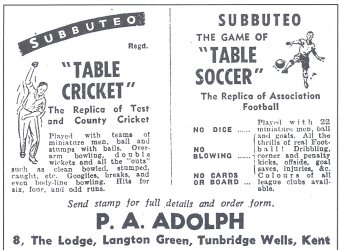
Pleasingly, Richard Payne dated his scanned adverts, so we know that a standard football advert (advertising the 1949-50 components list) was used in October 1949, and also that this lovely duel football/cricket advert appeared in April 1950.
Eagle. (No 47 - 2 March 1951)
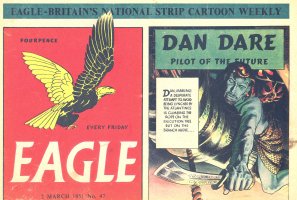
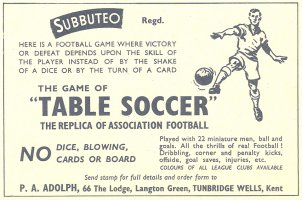
Eagle was the first of the great post-war UK comics. The magazine was founded by Marcus Morris, an Anglican vicar. He had noticed how popular the American comics were, with their stories produced in comic strip form rather than the prose stories in UK publications. So Eagle became "Britain's national strip cartoon weekly". However, Morris disapproved of the often violent American content, so Eagle had a wonderfully British feel to it. Eagle came in a large colourful newspaper sized format (the illustration above is of a folded copy. My scanner isn't big enough to do the whole thing....). The all-colour covers featured the legendary Dan Dare Pilot of the Future comic strip and are still iconic.
As Eagle is so closely associated with cover star Dan Dare, it might appear to be a slightly left-field place for a Subbuteo advert. However, the content is much more varied than Frank Hampson's sci-fi epic. The issue highlighted here has (a very old fashioned) public school soccer short story, and what was number eleven in a series of illustrated "Football Hints by Billy Wright - Captain of the Wolves and England."
The Subbuteo advertisement is still very basic, but it is a nice step up with the arrival of the classic short-sleeved footballer logo. It is worth pointing out that the "played with 22 miniature men" blurb is identical to the original 1946 advert. It shares an advertising place with (surprise) a foreign stamp offer, and an advertising comic strip for a Mars wafer bar called "Banjo" - which seems to be a kind of politically incorrect version of KitKat....
As mentioned elsewhere on the site, Subbuteo history writer Daniel Tatarsky has also written a "Dan Dare Biography" that is actually a very good history of Eagle magazine.
Charles Buchan's Football Monthly (1950s-70s)

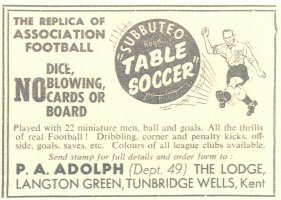
I don't own an issue of Charles Buchan's Football Monthly, so this cover and advertisement are courtesy of a retrospective published in 2008 and edited by my favourite football historian, Simon Inglis. Like Eagle, Buchan's was a revolutionary post-war product. As mentioned in the "Sport Magazine" section, there were plenty of sporting periodicals in this post-war era, they tended to be newspaper quality, usually mixed sports, and had football information mostly for players of the pools. Buchan's had a full colour cover (and later the odd full colour interior page featuring a player or team photo - perfect for your wall). It had better quality paper, and actually took the game seriously, with intelligent and informative articles. All this quality came with a higher price point. It cost 1/6d compared with the 6d of a publication like Sport shown above. It was a risk, but it proved to be a huge success through the 1950s and 1960s. It's popularity only really waned when it was replaced by the glossy weeklies, such as Goal (from 1968) and Shoot. Buchan's name was dropped in 1971, and it shrunk to a digest in 1973. That said, a Football Monthly of some form continued right into the 1990s.
Charles Buchan's was an adult publication with a price to match. However, it was enjoyed by children too, albeit probably the middle class ones on the whole. The magazine launched a "Buchan's Boys Club" to cater for this audience.
The advert featured was "selected from 1951-53" in the Simon Inglis book. The early date is confirmed by Adolph's address of "The Lodge", which was his mother's house. This seems to be the Subbuteo address until at least 1952. The usual Subbuteo blurb is matched with another classic Subbuteo logo.
Charles Buchan's Advert Gallery.
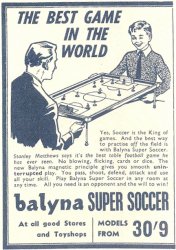
This was a long running magazine, and a popular place for Subbuteo to show their wares. I'll add a few more adverts if I am sent them. It was also used by Subbuteo's rivals, and the "Best of" book shown above features this great advert for Balyna Super Soccer (models from 30/9). If you don't own one of these, don't worry. It really wasn't "The Best Game in the World".
The Rover. (No 1460 - June 20th 1953)
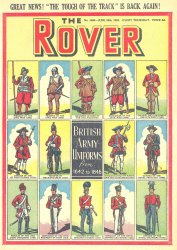
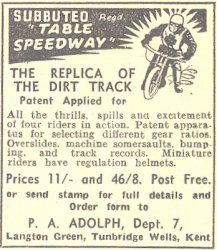
If Eagle was the revolutionary 1950s comic, then The Rover was very much part of the old guard. It had launched back in March 1922 (hence issue 1460), one of a series of DC Thomson publications, which fought with the more established Amalgamated Press (later Fleetway/IPC) for supremacy in the comic arena. DC Thomson's big four also included Adventurer (1921), The Wizard (1923), and The Hotspur (1933). The post-war Rover was little changed, with text stories throughout and no comic strips. The highlighted issue featured Alf Tupper "Tough of the Track" (who was later revived in comic strip form). Plus further stories featuring a WWII pilot, Russian circus horses, Jessie James, cricket and appropriately enough Speedway.
The Subbuteo advert is tiny, and tucked in alongside the usual ads for stamps, a bodybuilding club, and army surplus equipment (British army ridge tents, and German field binoculars). It is a nice little Speedway advert though, and gives a useful date for both the game and the track version. Peter Adolph's address is no longer at The Lodge.
I own four Rover comics of a similar date, and this is the only one to feature a Subbuteo advert. This might be due to the date (June) not being suitable for football game adverts.
The Rover Ad Gallery.
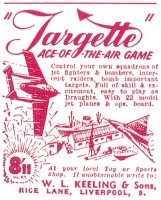
It wasn't only Peter Adolph who advertised in The Rover. Rivals WL Keeling & Sons (Newfooty) also used this publication. This advert for their Targette board game appears in the aforementioned hardback comic history When the Comics went to War, "as advertised in Rover, 8 September 1956."
Scorcher and Score - 28th August 1971
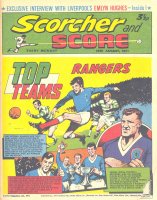
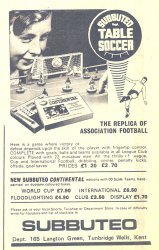
Whilst the long running Roy of the Rovers is the most famous all-football weekly comic, it was actually preceded in the IPC range by a pair of comics with a short but complicated history. IPC launched Scorcher in January 1970, and among the stories was the long running Billy's Boots. Initially it was successful, and as was their wont, it encouraged IPC to launch their own rival comic, Score 'n' Roar in September 1970. This tactic was designed to fill the market, and prevent rivals (i.e. DC Thomson) from cashing in. A similar tactic was used with 2000AD and Starlord, and perhaps Battle and Action too.
Score 'n' Roar was advertised as two comics-in-one, with Roar being a 16-page pull-out with its own cover. The two were tied together with cross-over strips about a pair of brothers - "Jack of United" in Score, and "Jimmy of City" in Roar. The most long-lived story was probably Nipper, about an orphan aiming to make it big at Blackport Rovers. Score 'n' Roar only lasted 35 issues, before being merged into the older magazine to become Scorcher and Score in July 1971. This title saw the introduction of another well-known character Hot-Shot Hamish in 1973, but this couldn't prevent the magazine folding back into Tiger in 1974 - two years before the Roy of the Rovers magazine launched.
The issue shown is from August 1971 and featured two full-page adverts for George Best branded footwear, and another full page ad for the footballer Action Man (with his George Best sideburns, he is probably even more of a collectable than Subbuteo). The Subbuteo advert by comparison is a small 1/6th of a page, and is actually one of their common 1960s adverts. The boy looks dated, and the red fence and floodlights are still in evidence. The blurb is much as it ever was. The Continental range is even still described as "new" which it hadn't been for a decade. At least the box set prices had been updated and the World Cup set mentioned. But Subbuteo's advertising revolution was yet to start.
World Soccer - March 1977 (Vol 17 No3).
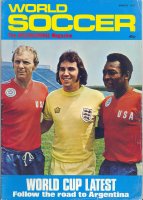
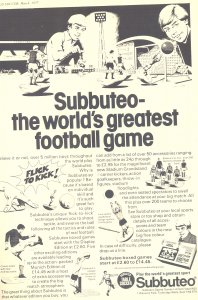
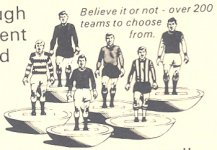
Website regulars will be familiar with this copy of World Soccer, which I've used to show how the West German teams on references 211-223 matched the German top flight of that year. However, it is also home to a large Subbuteo advert.
With UK newspapers and magazines rarely venturing outside our own shores, World Soccer has always been the gateway to the global goings-on of the beautiful game. The magazine began back in 1960, hence the reason this copy is in volume 17, and it is still going today. I read it regularly in the mid 2000s, when the magazine was perhaps at its height. At that point it was perfect-bound, and the reference section in the back finally moved from a cheaper paper to glossy. Sadly, this century and the internet have not been kind to magazines. WS has changed publishers a couple of times since then, and has shrunk alarmingly, whilst increasingly significantly in price. Still, I bought the Afcon preview edition this year - something of a tradition for me.
Back in 1977, World Soccer was a very basic production with less colour than even Charles Buchan's Football Monthly had in the 1950s. Only the front cover was colour, and not even the inside or back of the cover. Of course, it was the articles that were the main selling point. Then as now, they covered the basics (major European leagues, South America, World Cup), and a few more quirky subjects - this issue has The Kentish Cup (a cup played between the British, French and Belgian armies), and details of the Everton of Chile. Among the articles, we see Barcelona groaning under their debts, and poor but practical football dominating the Argentinean League... no change there then. Elsewhere, moans about a recent England defeat could have come from Charles Buchan's in the 1950s, or at any time since.... There were columns by Brian Glanville, and Paul Gardner in the US, who were still writing for WS when I was reading it 30 years later. Even more impressive is Keir Radnedge, who also has an article in the January 2022 issue, 45 years later..... That's a real love of his subject.
The 1977 Subbuteo advert is a full page affair, serious and wordy in a way that probably matched its surroundings quite well. Somewhat surprisingly, it appears to be the only advert in the whole magazine. It highlights the range of box sets, from Display to Munich. It advises that there are over fifty accessories, ranging from 24p to £2.95. The later the price of the new Stadium Grandstand (which is illustrated). It advises that there are over 200 teams to choose from. The illustrations show the corner kicker, throw-in figure and live-action goalkeepers. It is one of a series of full page adverts Subbuteo produced in this era, often with slight variations.
The Team Colours Project (Ongoing illustrated team lists).
Subbuteo Football boxed editions, Five-a-side and junior versions.
Subbuteo Catalogues: 1947-1970, 1971-1996 and misc flyers.